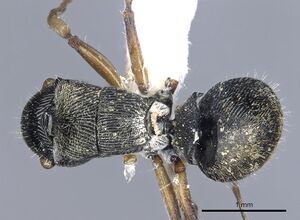Polyrhachis wilsoni
| Polyrhachis wilsoni | |
|---|---|

| |
| Scientific classification | |
| Kingdom: | Animalia |
| Phylum: | Arthropoda |
| Class: | Insecta |
| Order: | Hymenoptera |
| Family: | Formicidae |
| Subfamily: | Formicinae |
| Tribe: | Camponotini |
| Genus: | Polyrhachis |
| Subgenus: | Aulacomyrma |
| Species: | P. wilsoni |
| Binomial name | |
| Polyrhachis wilsoni Kohout, 2007 | |
Nothing is known about the biology of Polyrhachis wilsoni.
Identification
Kohout (2007) - A remarkable species, easily distinguished from all other known members of the subgenus by the very elongate, strongly divergent, propodeal spines.
Keys including this Species
Distribution
Distribution based on Regional Taxon Lists
Indo-Australian Region: New Guinea (type locality).
Distribution based on AntMaps
Distribution based on AntWeb specimens
Check data from AntWeb
Countries Occupied
| Number of countries occupied by this species based on AntWiki Regional Taxon Lists. In general, fewer countries occupied indicates a narrower range, while more countries indicates a more widespread species. |

|
Estimated Abundance
| Relative abundance based on number of AntMaps records per species (this species within the purple bar). Fewer records (to the left) indicates a less abundant/encountered species while more records (to the right) indicates more abundant/encountered species. |

|
Biology
|
Castes
Known only from the worker caste.
Images from AntWeb

| |
| Worker. Specimen code casent0009242. Photographer April Nobile, uploaded by California Academy of Sciences. | Owned by MCZ, Cambridge, MA, USA. |
   
| |
| Paratype of Polyrhachis wilsoni. Worker. Specimen code casent0903323. Photographer Z. Lieberman, uploaded by California Academy of Sciences. | Owned by NHMUK, London, UK. |
Nomenclature
The following information is derived from Barry Bolton's Online Catalogue of the Ants of the World.
- wilsoni. Polyrhachis (Aulacomyrma) wilsoni Kohout, 2007a: 214, figs. 47, 50, 53 (w.) NEW GUINEA.
Unless otherwise noted the text for the remainder of this section is reported from the publication that includes the original description.
Description
Worker
TL c. 4.13-4.84 (4.59); HL 1.12-1.28 (1.25); HW 1.00-1.15 (1.09); CI 87-92 (87); SL 1.22-1.31 (1.28); SI 114-122 (117); PW 0.94-1.09 (1.00); MTL 1.09-1.22 (1.22) (12 measured).
Anterior margin of clypeus arcuate with very shallow notch medially; in profile clypeus weakly convex. Sides of head in front of eyes gently converging anteriorly. Eyes convex, clearly breaking cephalic outline in full face view. Frontal carinae distinctly raised, sinuate; frontal area relatively wide, with short median carina that merges posteriorly into cephalic sculpture. Mesosoma marginate along entire length. Pronotal humeri armed with broad-based, triangular, blunt, teeth. Mesonotal and propodeal dorsa fused, with lateral margins deeply emarginate, terminating in very long, outwardly curved spines, their posterior margins continued as tranverse, deeply inwardly bowed ridges, that meet medially and separate propodeal dorsum from declivity. Petiole with sharp, dorsal margin, shallowly indented medially; lateral spines acute and curved backwards, their tips slightly upturned. Anterior face of first gastral segment concave, accommodating posterior face of petiole; anterodorsal margin of concavity distinct medially, but not raised above dorsal face of segment.
Sculpture of head, mesosoma and sides of gaster consisting of regularly spaced striae, mostly longitudinal on dorsum of head and sides of gaster, anteriorly converging on pronotal dorsum, converging posteriorly and joining along midline on mesonotal and propodeal dorsa. Propodeal declivity, petiole and dorsum of first gastral segment shagreened.
Abundant, yellowish, semi-erect to erect hairs present on all body surfaces and appendages, longest hairs almost as long as greatest diameter of eye. Hairs absent from inferior edges of scapes and dorsal surfaces of femora. Body with mostly off-white or yellowish, appressed pubescence, denser and silvery on metapleuron and reddish on gastral dorsum.
Black, with antennal scapes, distal portions of femora, proximal and distal ends of tibiae and basal segments of tarsi dark to medium brown; funiculi and rest of legs distinctly lighter, medium to light yellowish brown or reddish-yellow.
Type Material
HOLOTYPE: PAPUA NEW GUINEA, Huon Pen., lower Busu R., 5.v.1955, lowland rf., E. O. Wilson #950 (worker). PARATYPES: data as for holotype, but 3.v.1955, E. O. Wilson #895, 969 (3 workers) and 9.v.1955, E. O. Wilson #984) (worker); Bulolo, 3000ft, 19.xii.1970, rf., B. B. Lowery (4 workers); W. Bulolo, 2500ft, 22.xii.1970, rf., B. B. Lowery (3 workers). Type deposition: holotype and 2 paratypes in Museum of Comparative Zoology; 2 paratypes each in Queensland Museum, Australian National Insect Collection, The Natural History Museum and California Academy of Sciences.
Etymology
Named in honor of Prof. Edward O. Wilson of Harvard University, who collected many new Aulacomyrma species during his extensive field work throughout Papua New Guinea.
References
References based on Global Ant Biodiversity Informatics
- Janda M., G. D. Alpert, M. L. Borowiec, E. P. Economo, P. Klimes, E. Sarnat, and S. O. Shattuck. 2011. Cheklist of ants described and recorded from New Guinea and associated islands. Available on http://www.newguineants.org/. Accessed on 24th Feb. 2011.
- Kohout R.J. 2007. Revision of the subgenus Aulacomyrma Emery of the genus Polyrhachis F. Smith, with descriptions of new species (pp. 186-253). In Snelling, R.R., Fisher, B.L. & Ward, P.S. (eds). Advances in ant systematics: homage to E.O. Wilson 50 years of contributions. Memoirs of the American Entomological Institute 80: 690 pp.

